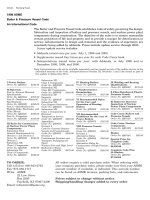Process Engineering Equipment Handbook 2009 Part 14 potx
Bạn đang xem bản rút gọn của tài liệu. Xem và tải ngay bản đầy đủ của tài liệu tại đây (3.26 MB, 80 trang )
changed. This has led to the development of two regulating methods that are now
in general use:
a. By installing a throttle valve, the boiler resistance curve is brought up to the
required higher pressure level (throttle regulation).
b. By varying the pump speed, the pump curve is changed (speed regulation).
Design of the boiler feed pump. The maximum continuous load of boiler must be
the basis for determination of the design point of the feed pump (see Fig. P-132).
1 = Boiler resistance curve in constant pressure operation
2 = Boiler resistance curve in varying pressure operation
3 = Pump curve of the half-load pump
4 = Pump curve of the full-load pump
5 = Maximum continuous rating of the boiler
6 = Design point
Pk = Maximum permissible boiler pressure
P-156 Power Transmission
FIG. P-130 Energy-saving curve with optimized ratio. Example: boiler feed pump drive. (Source:
J. M. Voith GmbH.)
FIG. P-131 Pump characteristics and boiler resistance curve. (Source: J. M. Voith GmbH.)
Power Transmission P-157
The pressure head of the feed pump must be so sized that the geodesic head can
be overcome and the required pressure increase, flow rate, and pressure losses plus
a 10 percent extra (related to the maximum boiler operating pressure) can be
attained.
For completeness, Fig. P-132 also has the curves for constant and varying
pressure operation. The fact that the position of these curves differs has no real
effect on the subject under discussion. Furthermore this introductory section only
deals with the basic outline of the considerations that affect the choice of a feed
pump.
Comparison between speed regulation and throttle regulation
OPTIMUM USE OF PUMP. Figure P-133 shows that with throttle regulation, the
throttle valve has to raise the boiler resistance curve even during full-load
operation. Each flow rate reduction required can only be achieved by artificially
further raising the boiler resistance curve. The delivery throttling therefore
decreases the unit’s efficiency since the power throttled off cannot be recovered.
With speed regulation of the pump only a relatively small speed change is
required to cover the whole boiler load, and the pump efficiency does not change
very much. Furthermore when the delivery rate drops the speed and pump loading
also drops, this means extended pump life due to reduced wear.
INCREASED PLANT LIFE. It is a general rule for all pump units (not only in power
stations) that speed regulation has a beneficial effect on performance and service
life, because the operating conditions in the pump are more favorable. If high-
pressure pumps in particular are run for a long period with the flow heavily
throttled back, overheating can occur leading to wear on the races, shaft bushes,
seals, etc. The other units around the pump are also loaded in that energy is put
FIG. P-132 Curves required for boiler feed pump design. (Source: J. M. Voith GmbH.)
FIG. P-133 Optimizing pump performance. (Source: J. M. Voith GmbH.)
into the flow and then destroyed by the throttle valve or transformed into heat; of
course the valve is itself very heavily stressed.
ENERGY SAVINGS
. As already mentioned, speed regulation saves energy that is
dependent on the load schedule and the pump and plant curves. A detailed,
quantitative analysis of these savings follows under “Efficient Energy Utilization
with Speed Regulation.”
EASIER MOTOR STARTUP. When an electric motor starts up, problems occur that
come under the heading breakaway torque, startup current, and motor design in
accordance with the startup conditions. The hydrodynamic coupling represents a
proven means of overcoming these problems.
Even the most unfavorable case, namely a blocked driven machine, would only
subject the motor to a load that rises to the square of the motor speed (see Fig.
P-134). This assumes the coupling is full (curve a in Fig. P-134) whereas in practice
the coupling filling is set to minimum during startup (curve b). In the case of
extreme requirements, the favorable behavior of the coupling is backed up by an
integrated hydraulic device, usually called a rapid start device. This means that
the motor can have a large acceleration capability at its disposal and really only
needs to overcome the inertias of the motor armature and coupling wheels.
Controlled loading by automatic filling of the coupling does not start until the most
favorable rated torque on the motor curve has been reached.
Since the hydrodynamic coupling is the connecting member between the motor
and the driven machine, it influences not only the motor-side startup conditions but
also those of the driven machine. By connecting the coupling’s scoop tube to suitable
control instruments or closed loops, it is possible to carry out complicated
operations, such as torque limitation, acceleration limitation, and startup time
P-158 Power Transmission
FIG. P-134 Torque versus speed for an asynchronous motor. (Source: J. M. Voith GmbH.)
FIG. P-135 Flow versus pressure pump characteristic. (Source: J. M. Voith GmbH.)
Power Transmission P-159
reduction. In the case of boiler feed pumps the ability of the standby unit to start
up very rapidly plays a major role in protecting the whole plant. This is one of the
reasons why the hydrodynamic variable-speed coupling has become such an
important element in power stations, since this condition is met simply by
connecting up the scoop tubes of two couplings in parallel and adapting the
hydraulic or electric control circuit accordingly.
The dynamic behavior of coupling together with the units they are connected to
is by now very well known, so the designer can be supplied with suitable data.
SEPARATION OF DRIVING AND DRIVEN MACHINES
. Separation of the driving and
driven machines can mean vibration and shock separation or absorption; it can also
include the possibility of power separation by draining the coupling. At all events
the hydrodynamic variable-speed coupling can optimally satisfy both requirements
that are of major importance as far as operating performance is concerned. Because
of the present-day speed and performance demands made on machines, shock and
vibration absorption is an important factor, not only when reciprocating with
rotating machine elements work together. The drainability of the coupling is mostly
used to protect the prime mover, i.e., to relieve the load on the motor, to avoid long-
duration startup current peaks, and to reduce the load on the mains. It is often the
case that large motor units are not shut down when the driven machine is to be
stopped and that frequent motor startups, and thus mains loading, are avoided
simply by draining and filling of the coupling. This means the plants are more
economical because of increased protection of the electrical and mechanical drive
elements even with very high startup frequency.
This subsection was a summary of the various factors that illustrate the
advantages of speed regulation using a hydrodynamic variable-speed coupling in
feed pump drives and that can be applied to these drives. Some of the factors
mentioned affect economy of operation indirectly rather than directly, e.g., reduced
breakdown rate, different design data for the whole plant, operating safety, and
flexibility.
Efficient energy utilization with speed regulation. To calculate the energy
savings achieved by speed regulation using a hydrodynamic variable-speed
coupling, the unit resistance curve, the characteristic pump curve for various
speeds, and the load schedule must be known. The unit and pump curves are
specified parameters and thus known within certain tolerances. This is not the case
with the load cycle, which depends on the interrelationship with other power
stations, the power increase or requirements over a large number of years, the block
size, etc. It is very difficult to make correct assumptions because the interdependent
factors are highly complex and the developments have to be assessed for a long time
ahead because of the normal amortization periods for large plants.
However the following calculation shows that speed regulation pays for itself very
quickly simply due to the throttle energy saved. It is therefore the author’s opinion
that a decision in favor of speed regulation is not really as difficult as it first appears.
The power consumption of the pump at the individual operating points i
corresponds to the following formula; the separate values for V
i
and p
i
out of the
unit resistance curve and the pump curve can be deduced.
(P-5)
P
a
= pump power consumption with throttle regulation
V
.
i
= oil flow
P
i
= pressure
h
i
= pump efficiency
PV
p
i
i
i
a
=◊
˙
h
The energy difference per pump unit is as follows:
(P-6)
P
Dri
= power requirements with throttle regulation
P
Dzi
= power requirements with speed regulation
t
i
= startup frequency at flow V
i
(h/year)
where the following applies:
P
Dri
= P
aDri
(pump power consumption with throttle regulation; see Fig. P-135).
Taking into consideration the efficiency and slip of the fluid coupling, the resultant
power requirements with speed regulation are:
(P-7)
P
aDzi
= pump power consumption with speed regulation (see Fig. P-136)
n
ao
= (maximum) pump speed with throttle regulation
n
ai
= pump speed with speed regulation
s
min
= minimum slip of fluid coupling in percent
a = symbol for mechanical efficiency of coupling (0.02 - 0.03)
Since Eq. (P-7) is an approximate formula for what is in reality a difficult physical
process, Eq. (P-7) should only be used as a rough calculation. Values a and s
min
in
Eq. (P-7) are average values reflecting the fluid coupling’s efficiency, which is in fact
dependent on the coupling size and type and the load. However the formulae are
accurate enough for our purposes and, being simplified, make it easier to
understand the basic interrelationships.
NUMERICAL EXAMPLE. The previous description of the economical factors is here
further clarified using a numerical example. Figure P-136 illustrates the following
calculations.
The example is based on a real medium size power station; some values that are
valid for this particular power station have been modified to make them of more
general application. The author believes that the data were selected to the
advantage of throttle regulation; this is dealt with in more detail in the following
section where the design values are discussed. This example is mainly meant to be
an example that can be quickly amended by introducing further data.
The throttle curve in Fig. P-136 is, because of its flat rise, more or less an ideal
throttle regulation curve.
Such a curve cannot always be achieved because in practice too flat throttle curves
mean instable pump behavior. Cases where the throttle curve does rise more acutely
mean higher energy losses for throttle-regulated plants.
The pump is normally designed so that maximum efficiency is achieved at the
point where the pump most often operates; this we have called normal point B
N
.
This applies both to throttle and speed regulation. However, with speed regulation,
the design efficiency can be maintained with very little deviation over a wide
regulating range whereas with throttle regulation the efficiency drops sharply as
the throttle regulation increases.
Three operating points are given in Table P-16.
The following are assumed: feed water temperature of 165°C, specific gravity of
900 kg/m
3
, and motor speed of 1480 1/min.
The appropriate coupling for these values is the hydrodynamic variable-speed
geared coupling type R 16 K-550. For clarity arrangement sketches have been added
PP
n
ns
a
Dzi aDzi
ao
ai min
100
100
1=◊◊
-
+
()
DE
total
Dri Dzi
1
=-
()
◊
=
Â
PPit
i
n
i
P-160 Power Transmission
Power Transmission P-161
(Figs. P-137 and P-138) showing the motor, feed pumps, and the coupling that
combines a mechanical gear and a fluid coupling.
The theoretical energy saving is opposed by the efficiency losses of the coupling,
detailed in Table P-17 as slip, and the resultant hydraulic and mechanical losses
(bearing friction, etc). The power losses were calculated by means of a table
computer program (see Table P-17).
We have assumed the pump efficiency for throttle regulation operation at the
corresponding points to be as follows:
Maximum performance B
M
h=0.76
Normal performance B
N
h=0.74
Minimum performance B
S
h=0.66
P
Vp mp
=
◊
=
◊
◊hrh
FIG. P-136 Comparison of throttle control and geared coupling control. (Source: J. M. Voith
GmbH.)
TABLE
P-16 Operating Points
mp n
a
P
a
t
Operating Point (kg/s) (bar) (1/min) (kW) (h/year)
Max. point B
M
172.5 209 5980 5348 50
Norm. point B
N
155 199.7 5870 4417 5000
Min. point B
S
122 182.2 5500 3236 2800
Table P-18 shows the result for the three load points: column one gives the
performance with throttle regulation using the above formula, column two the
performance with speed regulation taking account of the losses in the fluid coupling,
and column three the difference between the two.
It is immediately obvious from these results that throttle regulation is only
favorable for maximum power operation. However, this operating point is only used
under certain conditions and, even then, very rarely; this is why the second point
is called the normal point. When one considers the normal point and the minimum
power operating point, the advantage of speed regulation using a hydrodynamic
variable-speed coupling is unmistakable.
To be in a position to assess the difference between the two types of regulation
from the financial point of view, we must first establish an annual load schedule.
The schedule assumes that the power station block runs for 7850 hours per year
with 5000 hours at normal power. This assumption again favors throttle regulation
since power station blocks of this rating are used more for peak or average loads
and not, as assumed here, for base loads. The results in MWh are given in Table
P-19.
The 3757.15 MWh savings achieved by speed regulation using a hydrodynamic
variable-speed geared coupling means that the fluid coupling pays for itself in less
than a year, assuming a price per kWh of 0.03 DM.
The energy price is highly dependent on fuel costs, plant size, commercial
valuations, etc., but the assumed value should represent a reasonable mean value.
P-162 Power Transmission
TABLE
P-17
sP
vs
P
vm
Operation Point (%) (kW) (kW)
Max. point B
M
2.7 148 149
Norm. point B
N
4.5 208 155
Min. point B
S
10.5 382 172
P
vs
= hydraulic losses; P
vm
= mechanical losses in the coupling; s = slip.
FIG. P-137 Arrangement sketch: geared variable-speed coupling. (Source: J. M. Voith GmbH.)
Power Transmission P-163
The material in this case study resulted in a recommendation in favor of the speed
regulation of power station feed water pumps by hydrodynamic variable-speed
couplings. The extra unit pays for itself within approximately one year. A decision
in favor of speed regulation is indicated. Factors such as power station blocks
designed for based loads (i.e., high-performance blocks) being used for peak and
medium loads 5–10 years later support the decision.
FIG. P-138 Performance diagram: geared variable-speed coupling. (Source: J. M. Voith GmbH.)
TABLE
P-18 Results for Three Load Points
Throttle Speed Throttle
Regulation Regulation Coupling
Operating Point (kW) (kW) (kW)
Max. point B
M
5348 5645 -297
Norm. point B
N
5120 4780 340
Min. point B
S
4530 3790 740
TABLE P-19
Throttle Speed Throttle
Annual Op. Regulation Regulation Coupling
Hours (MWh) (MWh) (MWh)
B
M
= 50 267.40 282.25 -14.85
B
N
= 5,000 25,600.00 23,900.00 1,700.00
B
S
= 2,800 12,684.00 10,612.00 2,072.00
Total 7,850 38,551.40 34,794.25 3,757.15
Slip losses are small; they do not affect the efficiency of the total power station
much. However, consideration was paid to the possibility of bringing the slip losses
back to the working circuit, e.g., the power station circuit or the central heating
circuit by means of a heat exchanger. This means that speed regulation with the
hydrodynamic coupling proved itself superior to throttle regulation, and that speed
regulation has been improved.
Coupling selection
The design of a geared variable-speed coupling is mainly determined by the input
power and input speed of the driven machine. The performance diagram shows the
power transmitted by various coupling types and sizes, depending on the input and
output speeds.
Table P-20 shows varying equipment and design characteristics of the individual
types of geared variable-speed couplings. This information source has couplings for
individual applications. Matching coupling combinations are created by arranging
the gear stage and the coupling in relation to the required power, motor speed,
and speed of the driven machine. Coupling types are generally as follows (see Fig.
P-139):
1. A step-up gear is located in front of the coupling. This allows adaptation of high-
speed machines to the speeds of 2- or 4-pole squirrel cage motors (Type R K).
2. The coupling is driven direct and adapted to the speed required by the driven
machine by a step-up gear situated after the coupling. For high powers at very
high speeds (Type R . . . GS).
3. A step-up gear is located both at the input and the output side. This is suitable
for particularly high output speeds, e.g., with high-speed boiler feed pumps (Type
R KGS).
4. A step-up gear at the input side and a reduction gear at the output side make
this type into a fast reacting and compact coupling for fast response times (Type
R KGL).
P-164 Power Transmission
TABLE
P-20 Equipment and Design Characteristics
Gear Pump Scoop Tube Oil Flow
R8-13K Single-stage, Gear pump Hydraulically Constant
single helical operated
R8-13KGS Double-stage, Gear pump Hydraulically Constant
double helical operated
R . . . K Single-stage, Pump Direct Variable
double helical combination mechanically
operated
R . . . K551 Single-stage, Pump Hydraulically Variable
single helical combination operated
R . . . K265 Single-stage, Gear pump Hydraulically Variable
R . . . K375 single helical operated temperature
controlled
R . . . K550/ Single-stage, Pump Hydraulically Variable
600/630 double helical combination operated
R . . . KGS Double-stage, Pump Hydraulically Variable
R . . . KGL double helical combination operated
Slip losses are small; they do not affect the efficiency of the total power station
much. However, consideration was paid to the possibility of bringing the slip losses
back to the working circuit, e.g., the power station circuit or the central heating
circuit by means of a heat exchanger. This means that speed regulation with the
hydrodynamic coupling proved itself superior to throttle regulation, and that speed
regulation has been improved.
Coupling selection
The design of a geared variable-speed coupling is mainly determined by the input
power and input speed of the driven machine. The performance diagram shows the
power transmitted by various coupling types and sizes, depending on the input and
output speeds.
Table P-20 shows varying equipment and design characteristics of the individual
types of geared variable-speed couplings. This information source has couplings for
individual applications. Matching coupling combinations are created by arranging
the gear stage and the coupling in relation to the required power, motor speed,
and speed of the driven machine. Coupling types are generally as follows (see Fig.
P-139):
1. A step-up gear is located in front of the coupling. This allows adaptation of high-
speed machines to the speeds of 2- or 4-pole squirrel cage motors (Type R K).
2. The coupling is driven direct and adapted to the speed required by the driven
machine by a step-up gear situated after the coupling. For high powers at very
high speeds (Type R . . . GS).
3. A step-up gear is located both at the input and the output side. This is suitable
for particularly high output speeds, e.g., with high-speed boiler feed pumps (Type
R KGS).
4. A step-up gear at the input side and a reduction gear at the output side make
this type into a fast reacting and compact coupling for fast response times (Type
R KGL).
P-164 Power Transmission
TABLE
P-20 Equipment and Design Characteristics
Gear Pump Scoop Tube Oil Flow
R8-13K Single-stage, Gear pump Hydraulically Constant
single helical operated
R8-13KGS Double-stage, Gear pump Hydraulically Constant
double helical operated
R . . . K Single-stage, Pump Direct Variable
double helical combination mechanically
operated
R . . . K551 Single-stage, Pump Hydraulically Variable
single helical combination operated
R . . . K265 Single-stage, Gear pump Hydraulically Variable
R . . . K375 single helical operated temperature
controlled
R . . . K550/ Single-stage, Pump Hydraulically Variable
600/630 double helical combination operated
R . . . KGS Double-stage, Pump Hydraulically Variable
R . . . KGL double helical combination operated
Power Transmission P-165
FIG. P-139 Generic hydrodynamic coupling types and dimensions in mm. (Source: J. M. Voith GmbH.)
P-166 Power Transmission
Geared variable-speed couplings for low-speed machines
Design and function. A reduction gear is located after the coupling for applications
in the drives of low-speed machines. The coupling and the gear are contained in a
common housing the lower part of which is designed as an oil tank.
By the optional installation of a hydrodynamic retarder with favorable braking
characteristics, a high retardation of large masses of the connected driven machine
is achieved.
Speed control is carried out by changing the oil-fill of the coupling through the
scoop tube that reaches into the working chamber of the coupling. The transmitted
power and the speed can be controlled steplessly. (See Fig. P-140.)
Oil supply. Working and lube oil are both supplied by the integrated oil tank,
however, from separate circuits. The oil supply for the motor and the driven
machine may also originate from this source.
Performance diagram. This serves to identify the appropriate coupling types and
sizes in relation to the input power and the required output speed.
Coupling types. Controlling low-speed machines such as coal mills, induced
draught fans, and crude oil pumps demands different coupling designs.
Depending on the application and for optimum adaptation to existing space
conditions, the gear stage is either designed as helical or bevel gear.
Genetic coupling types are as follows (see Fig. P-141):
1. A helical step-down gear is arranged behind the variable-speed turbocoupling.
This type is suitable for applications in coal mills, crushers, low-speed pumps,
and fans (Type R A).
2. Geared variable-speed coupling for low-speed driven machines with high
moment of inertia, e.g., coal mills. This type features a bevel gear stage behind
the turbocoupling (Type R B).
Torque Conversion*
A torque converter can be used where torque and speed have to be transmitted or
controlled between a driving and a driven machine in a simple and economical way.
A torque converter is “open” to both sides. It absorbs torque from the driving
machine and transmits it according to requirement to the driven machine. This
process is governed by the “natural” characteristics of the converter, or can be
controlled at will by varying the pitch of the guide blades (adjustable converter).
In both cases, the converter can be incorporated in a process control system.
In this prospectus, the attempt is made with examples to concisely yet clearly
describe the hydrodynamic torque converter, its characteristics, and its application
possibilities.
The most important areas of application are listed in Fig. P-142. Note symbols
in Fig. P-143.
When is it expedient to use a simple torque converter and when an adjustable
one? This varies from case to case. The most important criteria in this decision are
the characteristics of the prime mover and the load curve governed by the job to be
handled.
What is regulated, what is controlled?
See Figs. P-144 through P-146.
* Source: J.M. Voith GmbH, Germany.
Power Transmission P-167
FIG. P-140 Geared variable-speed coupling for low-speed machines. (Source: J. M. Voith GmbH.)
P-168 Power Transmission
FIG. P-141 Generic model of geared variable-speed couplings for low-speed machines. (Source:
J. M. Voith GmbH.)
FIG. P-142 Torque conversion applications. (Source: J. M. Voith GmbH.)
FIG. P-143 Symbols for a torque converter and an adjustable torque converter. (Source: J. M. Voith
GmbH.)
P-169
How the torque converter works
The pump impeller of the converter, a centrifugal pump, converts the torque M
P
absorbed from the motor into kinetic energy in a fluid mass. See Fig P-147.
In the turbine wheel the fluid mass is decelerated producing the turbine torque
M
T
. The guide wheel (reaction member) absorbs the differential torque M
R
between
input and output torque that results in the multiplication of torque. The ratio and
curve of torque multiplication M
T
/M
P
is conditioned by the form of the converter
blades.
FIG. P-144 Using a motor of constant speed and a torque converter without adjustment mechanism, jobs such as startups
can be undertaken smoothly and steplessly along the “natural” characteristic curve of the converter. This is a starting
process. The operating range is centered around peak efficiency. (Source: J. M. Voith GmbH.)
FIG. P-145 Using a variable-speed motor and a nonadjustable torque converter, a method of regulation is obtained that
permits any desired curve to be operated corresponding to the input/output speed ratio. This case illustrates how the
efficiency peak remains practically the same. (Source: J. M. Voith GmbH.)
FIG. P-146 Using a constant-speed motor and an adjustable torque converter, any operating point can be run within the
characteristic range of the turbine, e.g., a constant torque can be held under fluctuating load or specific speeds in
alternating succession. At first glance, an adjustable torque converter works uneconomically in specific ranges, because
the efficiency decreases with progressively closed guide blades. This is deceptive. If one projects the operating points from
the turbine characteristic range onto the efficiency curves, the result is a good overall efficiency. (Source: J. M. Voith
GmbH.)
144 145 146
P-170 Power Transmission
Power Transmission P-171
For this reason, every converter design has its own characteristic family of curves.
The integral gear pump produces the necessary operating pressure and dissipates
heat generated by directing the oil stream to the cooling unit.
Application case 1: Gas turbine starting
The gas turbine is loaded by its compressor and the mass of the generator. It cannot
be started without assistance. As a starting motor either an electric motor can be
1
2
3
4
1
4
2
3
FIG. P-147 Torque converter components. (Source: J. M. Voith GmbH.)
P-172 Power Transmission
used, providing that sufficient power can be taken from the mains, or alternatively
a diesel engine. See Fig. P-148.
Possible solutions. The torque converters shown in Figs. P-149 through P-152 can
be employed wherever large masses have to be accelerated rapidly and smoothly,
wherever high breakaway torque has to be overcome, and wherever speeds have to
be automatically adapted to loads.
A torque converter, however, is not only an efficient but also an economical
solution to a drive problem: low prime costs, low space requirements, and practically
wear-free operation are facts which speak for this.
Torque converters for gas turbine starting sets are particularly adaptable.
They can be supplied with a filling and draining facility of with a guide blade
adjustment mechanism; in all cases, the blading can be matched to the torque
loads to be handled. Previously supplied torque converters include those
with ratings up to 4000 kW at speeds of 3600 1/min (60 Hz) and 3000 1/min
(50 Hz).
The operating fluid for the torque converter is taken from the lube oil system of
the gas turbine. The oil tank simultaneously serves as a heat accumulator.
Application case 2: Variable-speed engine and fluctuating loads (Figs. P-153 through P-159)
Several diesel engines drive the drilling rods, lifting gear, and mud pumps through
a chain compound under constantly fluctuating load. During drilling, speeds must
be steplessly varied and shock loads absorbed. At the same time, the mud pumps
press flushing and ballast material into the drill-hole at different rates and
pressures to flush out the drill cuttings. The lifting gear works with high
acceleration and retardation when the, often, several thousand meters long drilling
rods need to be dismantled quickly. The automotive governed diesel engines, with
their available speed and torque capacity, are incapable of fulfilling these tasks
satisfactorily.
Possible solutions. Both types of converters are also suitable for other similarly
loaded machines, e.g., heavy earth-moving machines, light shunting locomotives,
FIG.
P-148 Schematic of a torque converter in a drivetrain. (Source: J. M. Voith GmbH.)
Power Transmission P-173
scrapers, loader plants, bucket dredgers, cranes, and winches. The converter
protects the plant from overload and overdrive, matches itself steplessly and
automatically to arising resistance, and dampens shock and vibration between
driving and driven machines. The use of a torque converter substantially increases
the length of life reliability of a plant.
FIG. P-149 Torque converter with constant filling. The gas turbine is brought out of standstill at a
high breakaway torque and is accelerated under increasing compression resistance to firing
speed. After this, hot combustion gases in the turbine support the compressor so that with
increasing speed the torque requirement decreases up to the self-sustaining speed of the turbine.
When this speed has been reached, the starting equipment is disengaged by means of an SSS-
clutch. The gas turbine oil tank serves as an accumulator for heat generated in the torque
converter. (Source: J. M. Voith GmbH.)
FIG. P-150 Torque converter with filling and draining control. With the torque converter drained,
the starting motor is accelerated up to rated speed. After this, the converter is filled and the gas
turbine started as under Fig. P-149. To disengage the starting equipment, the torque converter is
simply drained. A freewheeling device is dispensed with. (Source: J. M. Voith GmbH.)
FIG. P-151 Torque converter with filling and draining control and guide blade adjustment (C1). A
torque converter equipped in this way fulfills the functions described under Figs. P-149 and P-150.
Additionally, the gas turbine can be held constant at any required speed. A similar influence on
speed is obtained by varying the circulating oil flow, e.g., by accurately dosed ventilation of the oil
circuit (C2). (Source: J. M. Voith GmbH.)
151
P-174 Power Transmission
Application case 3: Speed and torque regulation (Figs. P-160 through P-165)
Reciprocating machines work at both low and high speed, mostly against a constant
pressure, and therefore require a constant torque. Rates of delivery should be
precisely and steplessly adjustable. High efficiency is desired throughout the entire
operating range. With explosive media, flameproof protection is to be provided.
Possible solution. An electric motor with constant speed and an adjustable torque
converter (torque converter with adjustable guide blade mechanism) form an ideal
variable drive unit for reciprocating pumps. It is easy to regulate and therefore
suitable for any process control; the efficiency is good when compared with that of
other types of regulation. Figure P-142 demonstrates that the adjustable torque
converter is used in reciprocating pump drives.
Torque converter (compact design Vorecon® type RWE)
In its most compact form, the RWE-type Vorecon comprises the main components
of a hydrodynamic adjustable torque converter, a fixed planetary gear, and a
revolving planetary gear in a common housing. (See Figs. P-166 and P-167.)
FIG. P-152 Torque converter models available. (A) Type E (L) 10z FG. Power rating = 1416 kW at
2950 1/min (gas turbine GTMS 9001 E, 50 Hz). Effective operating range 80 percent. Peak efficiency
34 percent. Optional: filling and draining facility or guide blade adjustment. (B) Type E 8.5 wG (F).
Power rating = 560 kW at 210 1/min (gas turbine TG 20/B2, 50 Hz). Special feature: 4-fold torque
multiplication. Optional: filling and draining facility. (Source: J. M. Voith GmbH.)
Power Transmission P-175
FIGS. P-153, P-154, P-155, P-156, P-157 A torque converter is mounted on the output end of each
diesel engine. A torque converter compensates automatically fluctuations in torque, isolates
vibrations, dampens shock loads, and can be overloaded. These qualities are of particular
significance in multiple drive plants with widely differing loads. The waste heat generated in the
converter is dissipated in an oil cooler. (Source: J. M. Voith GmbH.)
153
154
156
155
157
FIG. P-158 (A) Torque converter type C–B. Power range 50–1000 kW. Special features:
Synchronous converter (no torque absorption at full output speed); therefore, no overload
protection required. Effective operating range = 100 percent. Peak efficiency at 80 percent. Can be
flange-mounted on a diesel engine; own lube oil system (oil sump and mechanical oil pump).
Cooling via engine cooling unit or oil/air cooler (supplied as optional extra). (B) Torque converter
type E. . .y. Power range 50–1000 kW. Special features: High starting torque multiplication, no
engine lug-down. Effective operating range = 80 percent. Peak efficiency at 55 percent. Can be
flange-mounted on a diesel engine; own lube oil system (oil sump and mechanical oil pump).
Cooling via engine cooling unit or oil/air cooler (supplied as optional extra). (Source: J. M. Voith
GmbH.)
P-176 Power Transmission
Function. The Vorecon works on the principle of a power split.
The adjustable torque converter is used to “take off” a small part of the power
from the main shaft and feed it to the revolving planetary gear via the fixed
planetary gear.
By adjusting the position of the guide vanes of the torque converter, the output
speed is varied.
The major portion of the power is transmitted purely mechanically and thus with
hardly any loss via the main shaft and the planetary drive.
This produces a very high degree of efficiency for the entire unit over the speed
range.
For type RWE the speed range is approximately 60 to 100 percent.
Power Transmission P-177
Because of its short, coaxial form, the RWE is extremely space-saving and has
very low capital cost.
Applications. The principal applications for this version are in the drives of boiler
feed pumps, compressors, and other high-speed machinery with a limited speed
range.
Expanded speed range application (Vorecon® type RWS)
In addition to the torque converter, fixed gear, and revolving gear unit, the RWS
version has a hydrodynamic adjustable brake (retarder). (See Figs. P-168 and P-
169.)
Function. Operation of the Vorecon type RWS can in principle be split into two
operating ranges.
In operation range 1 the retarder is filled with oil and the torque converter is
drained. Torque support of the superimposing system is affected by the retarder
that has variable guide vanes. Adjusting the guide vanes alters the output speed.
On reaching the changeover point, the retarder is drained and the torque
converter “takes over” operating range 2.
The changeover point can be fixed between 70 and 85 percent of the nominal
speed by appropriate selection of gearing ratio, during the design phase.
This means that the optimum efficiency of the drive can be adjusted to the load
schedule of the plant.
The overall speed-regulating range of the Vorecon type RWS is approximately 45
to 100 percent.
It is this expanded speed range, compared with the RWE, that characterizes the
application areas of this version.
Relieved startup application (Vorecon® type RW)
In this type of RW multistage variable-speed drive, a hydrodynamic variable-speed
coupling with scoop tube and lockup clutch is incorporated in front of the torque
converter.
FIG.
P-159 Power versus efficiency characteristics of C–B and E . . . y converters. (Source. J. M.
Voith GmbH.)
P-178 Power Transmission
FIG. P-160 Schematic of a torque converter in a process pump train. (Source: J. M. Voith GmbH.)
FIGS.
P-161, P-162 Characteristics of torque converter used in reciprocating machinery trains.
(Source: J. M. Voith GmbH.)
FIG.
P-163 Torque converter schematic (see also Fig. P-164). (Source: J. M. Voith GmbH.)
161
160
163
162









